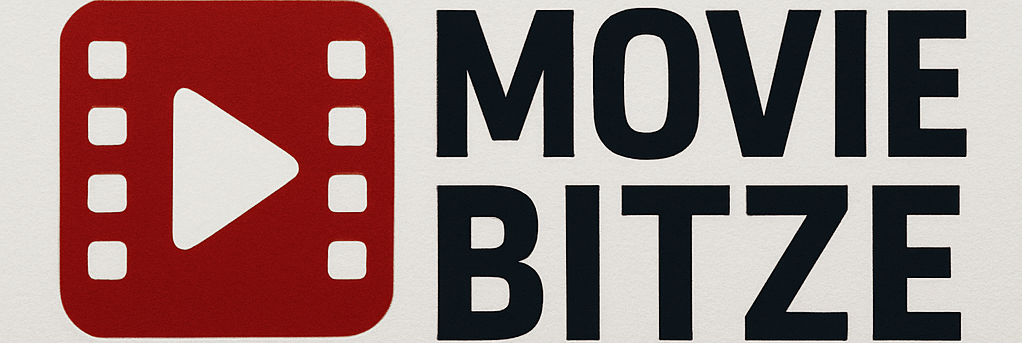The Odyssey (2026) Explained:
The Odyssey (2026) is set to be Christopher Nolan’s most ambitious film to date—a mythic action epic shot entirely with new IMAX film cameras, carrying a reported budget of $250 million. Following the critical and commercial success of Oppenheimer, Nolan has chosen to adapt one of the foundational texts of Western civilization: Homer’s ancient Greek poem chronicling the 10-year journey of Odysseus, King of Ithaca, as he attempts to return home after the Trojan War.
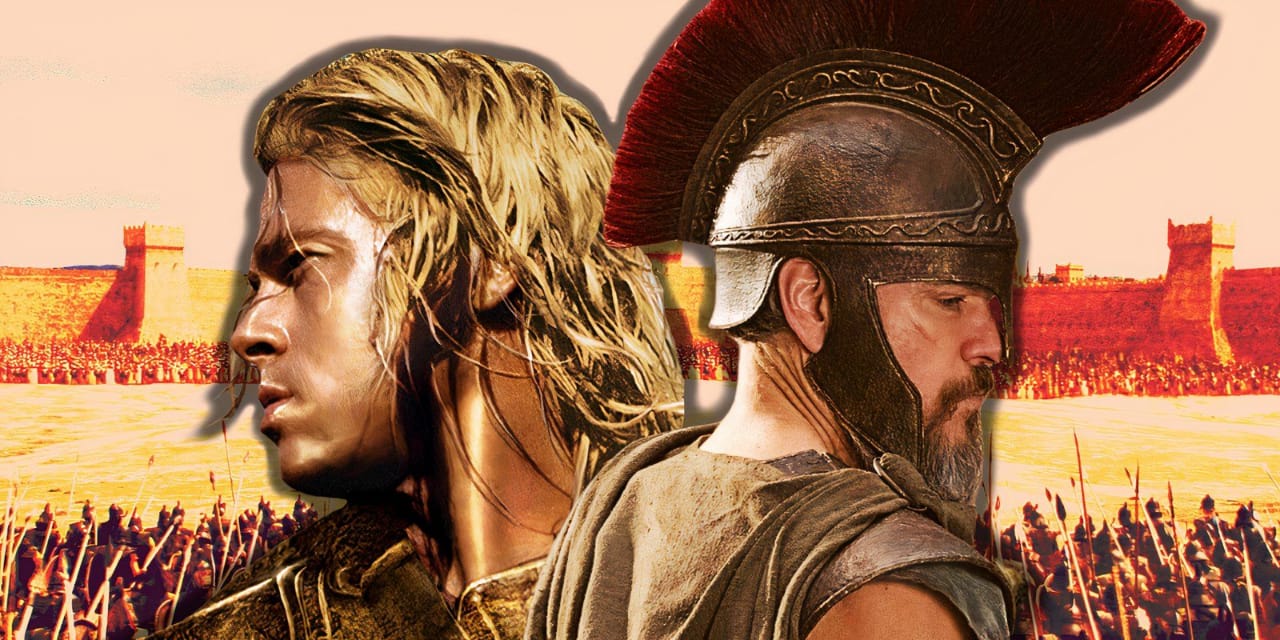
This is not a simple war story, but a complex narrative about endurance, identity, and the relentless march of time. Nolan’s involvement immediately signals that this will be a faithful but conceptually modernized take, using his signature non-linear structure and fascination with time distortion to explore the psychological toll of a decade lost at sea.
This exhaustive 3000-word explanation will serve as your definitive guide to Nolan’s vision. We will break down the three structural pillars of the original epic and speculate on how Nolan will use the vast ensemble cast—including Matt Damon (Odysseus), Anne Hathaway (Penelope), and Tom Holland (Telemachus)—to weave a complex, time-bending tapestry of mythology, action, and human drama, culminating in the ultimate homecoming.
I. The Core Thematic Challenge: Nolan, Time, and The Odyssey
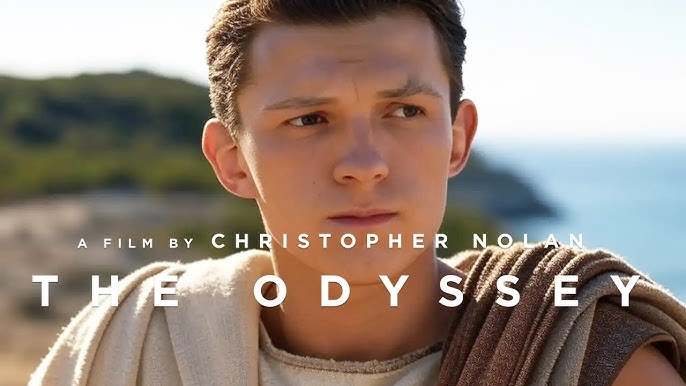
Christopher Nolan has made his career exploring the concept of time—its relativity, its elasticity, and its devastating psychological effects (Memento, Inception, Interstellar, Dunkirk, Oppenheimer). The Odyssey, a poem centered on a 10-year delay, is a perfect fit for his sensibilities.
A. The Non-Linear Narrative Structure (In Medias Res)
The original poem is structured in medias res (starting in the middle), and Nolan is almost guaranteed to double down on this concept, using his signature flashback and cross-cutting techniques.
- The Opening: Homer’s poem opens not with Odysseus, but with his son, Telemachus, in Ithaca, facing the insolent suitors. Nolan will likely begin here, establishing the dramatic tension of the home front before diving into Odysseus’s own story. This allows the film to immediately establish a ticking clock—Penelope is running out of time before she is forced to remarry.
- The Phaeacian Flashback: Odysseus is introduced only after he has been shipwrecked and washes ashore on the island of the Phaeacians. The traditional narrative has him recount his entire 10-year journey in a single, lengthy flashback. Nolan will likely use this mechanism—Odysseus telling his tale—to justify constantly shifting timelines, allowing him to jump between:
- Ithaca Present: Telemachus and Penelope fighting the suitors.
- Odysseus Present: His final voyage home and his time as a captive of Calypso.
- Odysseus Past: The 10 years of legendary trials (Cyclops, Circe, Sirens, etc.).
- Thematic Overlap: This structure allows Nolan to explore how time warps memory and identity. For Telemachus, his father is a myth; for Penelope, he is a ghost; for Odysseus, his own past is a string of impossible, often hallucinatory, traumas that have fundamentally changed who he is.
B. The Psychological Toll of 10 Years
The film’s central drama is not the monsters; it’s the erasure of identity that comes with extended suffering.
- Odysseus’s Trauma: The man who left for Troy was a brilliant strategist (The Iliad); the man who returns is a scarred, broken survivor. Nolan will likely use a grounded, gritty approach (similar to Dunkirk) to depict the physical and psychological toll of war and loss, making the encounter with the monstrous less about fantasy and more about hallucination, delirium, and PTSD.
- The Disguise: Odysseus returns to Ithaca in disguise, aided by Athena. This act is essential to the story and perfectly aligns with Nolan’s preoccupation with masks and hidden identities (Batman, Inception). Why hide? Because he is a different man, and he needs to observe if his world is still worthy of him.
II. The Three Pillars of the Narrative: Ithaka, The Journey, and The Gods
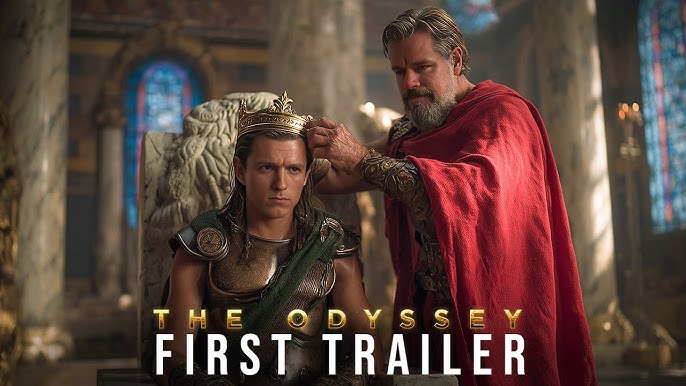
The 24 books of Homer’s epic can be grouped into three distinct acts, each with unique casting and thematic demands.
A. Pillar 1: Telemachus and Penelope (The Home Front)
The first four books of the poem focus entirely on the domestic drama, and the film will dedicate a significant portion of its runtime here, using the massive cast to build emotional tension.
- Penelope (Anne Hathaway): Hathaway’s role is arguably the most demanding. Penelope is the symbol of loyalty, but also of cleverness and resilience, using tricks (like the weaving of Laertes’ shroud) to delay the more than 100 suitors. Her arc is about maintaining order against chaos and holding onto hope against all evidence.
- Telemachus (Tom Holland): Holland’s casting as the young prince is pivotal. Telemachus is growing up under the shadow of his famous, missing father, constantly belittled by the suitors. His journey, encouraged by the disguised Athena (Zendaya), is one of coming-of-age—moving from a helpless boy to a man capable of fighting for his home.
- The Suitors: Led by Antinous and Eurymachus (likely played by key ensemble actors), the suitors represent the decay of civilization and the corruption of hospitality. Their sheer numbers and arrogance provide the immediate, tangible threat that drives the film’s climax.
B. Pillar 2: The Voyage (The Mythic Trials)
This is the core of the epic, where Nolan’s use of IMAX and practical effects will be fully deployed. These legendary encounters showcase Odysseus’s wit and physical endurance.
- The Lotus-Eaters: This brief stop introduces the theme of forgetfulness and the seductive power of ease. In Nolan’s hands, this could become a trippy, Inception-like scene where Odysseus must violently pull his men back from a pleasant, memory-wiping stupor—a metaphor for escaping the temptation to give up the arduous journey home.
- The Cyclops (Polyphemus): The blinding of the Cyclops is the inciting incident for the entire story’s tragedy, as Polyphemus is the son of Poseidon (the god of the sea, who becomes Odysseus’s chief divine antagonist). The scene demands strategic brilliance from Odysseus (using the name “Noman”) over brute strength.
- Circe (Charlize Theron): Theron’s casting as the powerful goddess of sorcery who turns Odysseus’s men into pigs is a highlight. This encounter, which sees Odysseus compelled to remain on her island for a year, allows Nolan to play with the elasticity of time. A single year feels like nothing to an immortal goddess, but like a lifetime to a desperate mortal.
- The Sirens & Scylla/Charybdis: These sequences are tailor-made for IMAX spectacle. The Sirens represent the seduction of the past (they sing of his glories at Troy), forcing Odysseus to bind himself to the mast while his men plug their ears—a physical manifestation of willpower against temptation. Scylla (the six-headed monster) and Charybdis (the whirlpool) are pure nautical terror.
- The Descent to the Underworld (The Necromancy): Odysseus’s journey to the realm of the dead to speak with the prophet Tiresias allows Nolan to bring back key Iliad characters (Achilles, Agamemnon, etc.) and gives Odysseus a moment of final, despairing confrontation with the ghosts of his war trauma.
C. Pillar 3: The Gods (The Divine Intervention)
The gods in The Odyssey are not passive; they are active, petty, and powerful players in human affairs.
- Athena (Zendaya): As the goddess of wisdom and war, Athena is Odysseus’s divine protector. She is the strategist who respects Odysseus’s intellect. Zendaya’s role is central to the film’s structure, as she is the one who constantly advises and even disguises Odysseus, serving as a metaphysical director of the human drama.
- Poseidon (Casting Speculation): As the primary antagonist god, Poseidon’s fury drives the storms and shipwrecks. Nolan’s visuals will likely make Poseidon’s influence a constant, terrifying, and practical weather threat—not necessarily a CGI figure, but a relentless force of nature.
- Hermes (Robert Pattinson): Pattinson’s role as the swift messenger of the gods, who delivers the decrees from Olympus, allows him to glide between the human world and the divine, serving as a cosmic narrator or facilitator, perfectly fitting Nolan’s use of multi-layered casting.
III. Casting Nolan’s Pantheon: The Star-Studded Ensemble
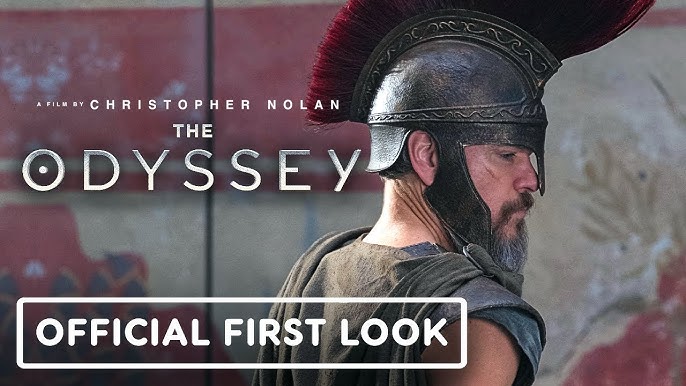
The confirmed cast list is a who’s who of Nolan alumni and global stars, signaling the high stakes of the project.
- Matt Damon as Odysseus: Damon brings the necessary world-weariness, physical capability, and underlying intelligence to the role. His familiarity with Nolan’s demanding physical and psychological shoots (e.g., Interstellar, Oppenheimer) makes him the ideal choice to anchor the 10-year physical and mental ordeal.
- Anne Hathaway as Penelope: Hathaway brings the regal intelligence and emotional depth required for a character defined by two decades of patience and profound loss.
- Tom Holland as Telemachus: Holland provides the necessary youthful energy and sense of journey. His arc is the coming-of-age story that grounds the mythological elements.
- The Cameos and Key Roles: The vast ensemble (Zendaya, Robert Pattinson, Charlize Theron, Lupita Nyong’o) will allow Nolan to populate the mythological landscape with powerful, recognizable faces, lending weight to even small, critical roles like Circe, Athena, and key figures from the Underworld.
IV. The Climax: The Unmasking and The Reckoning
The film’s final act will be a visceral and emotional explosion, setting up the ultimate moment of recognition.
A. The Bow Contest
The first step in the final confrontation is the iconic contest where Penelope challenges the suitors to string Odysseus’s great bow and fire an arrow through the holes of twelve axe-heads. This scene is built on deception and revelation.
- Odysseus’s Power: Disguised as a beggar, only Odysseus is capable of performing the feat, proving his identity through his inherent, unmatched skill. This is the moment the tables turn—the suitors realize their doom, and Penelope realizes her husband has returned.
- The Final Battle: The slaughter of the over 100 arrogant suitors, aided by Telemachus, Athena, and a handful of loyal servants, will be a visceral, contained action sequence. Nolan is expected to film this with his characteristic, grounded brutality, showing the tragic conclusion of the long-abused laws of hospitality.
B. The Final Test of Penelope
The final, deeply emotional scene is the reunion between Odysseus and Penelope. Even after the slaughter, Penelope does not immediately recognize or trust him.
- The Marriage Bed: Penelope asks the maid to move the marriage bed, a trick designed to test his memory. Odysseus built their bed into the base of a massive olive tree, a secret only the two of them know. His enraged reaction that the bed cannot be moved proves he is truly her husband.
- The Theme of Endurance: This moment is the emotional climax: the proof that memory and shared history are the only things that truly endure the test of time, war, and separation. This intimate moment is the ultimate payoff for Nolan’s epic scale.
V. Conclusion: An IMAX Epic for the Ages
The Odyssey (2026) is destined to be a cinematic masterpiece that utilizes Christopher Nolan’s technological ambition (IMAX-only shooting, global locations) to honor the psychological depth of Homer’s original narrative.
By focusing on the non-linear path, the mental and physical toll of the decade-long separation, and the complex relationships of the star-studded ensemble, Nolan is transforming a 3,000-year-old story into a timeless exploration of who we are after the trauma of war, and what it truly means to come home. The film promises to be a powerful reminder that the true struggle in any epic is always the fight to maintain one’s own identity.
